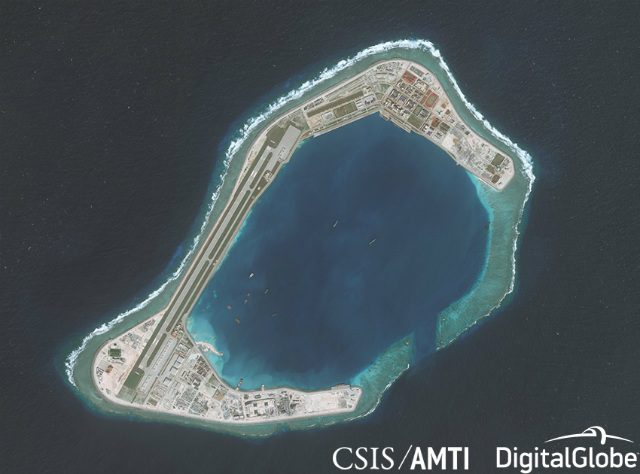SUMMARY
This is AI generated summarization, which may have errors. For context, always refer to the full article.

MANILA, Philippines – China has constructed more than 1,600 structures in the disputed South China Sea, and nearly half of these can be found in waters belonging to the Philippines.
This is based on data exclusively reviewed and published by Reuters on Thursday, May 24.
The data came from the non-profit group Earthrise Media, which analyzed satellite images by DigitalGlobe. The building counts spanned the years 2014 to 2017.
Basd on these data, nearly 800 of these Chinese structures can be found in the West Philippine Sea, the part of the South China Sea that belongs to the Philippines. In particular, the Chinese structures can be found on the artificial islands constructed on the following reefs:
- Subi Reef, “now home to nearly 400 individual buildings,” according to Reuters
- Mischief Reef and Fiery Cross Reef, that “each house almost 190 buildings and structures”
China has constructed hundreds of other structures on the Paracel Islands, which the Philippines does not claim.
All in all, China has built 1,652 buildings in both the Spratly Islands, which the Philippines claims, and the Paracels.
“In total across both island chains, China has erected more structures than all other occupants combined,” Reuters reported.
Here is Reuters’ breakdown of the structures built by different claimants the South China Sea:
- China – 1,652 buildings
- Vietnam – 338 buildings
- Philippines – 100 buildings
- Taiwan – 37 buildings
- Malaysia – 28 buildings
Reuters also noted the “shift of focus and massive expansion in the Spratlys” as of 2017.
Between 2014 and 2015, for example, there were 554 buildings in the Spratlys and 730 in the Paracels.
A few years later, there were already 1,350 buildings in the Spratlys and 805 in the Paracels.
“Most of this is due to China’s island-building drive there,” Reuters reported.
Capable of holding up to 2,400 troops
DigitalGlobe images “show neat rows of basketball courts, parade grounds, and a wide variety of buildings, some flanked by radar equipment,” according to Reuters.
“Subi is the largest of China’s seven man-made outposts in the Spratlys. The so-called ‘Big Three’ of Subi, Mischief and Fiery Cross reefs all share similar infrastructure – including emplacements for missiles, 3-km runways, extensive storage facilities, and a range of installations that can track satellites, foreign military activity and communications,” the wire agency reported.
Analysts cited by Reuters, including Singapore-based Collin Koh, “said the facilities on Subi, Mischief, and Fiery Cross could each hold a regiment – between 1,500 to 2,400 troops.”
Rappler is still trying to reach the Philippine Department of Foreign Affairs for comment as of posting time.
The Reuters report comes after Chinese state media said Chinese bombers have landed for the first time on an island in the South China Sea.
The DFA has chosen not to publicly condemn China over these bombers, saying it was not its policy to “publicize every action” it takes.
President Rodrigo Duterte earlier stressed the need to remain “meek and humble” to receive the “mercy” of the likes of Chinese President Xi Jinping.
Acting Chief Justice Antonio Carpio and former Philippine foreign secretary Albert del Rosario, however, urged the Philippine government to file a diplomatic protest over the Chinese bombers.
“Failure to formally protest means the Philippines is acquiescing or consenting to the militarization, and worse, to the claim of China that all the islands, waters, and resources within the 9-dash line form part of Chinese territory,” Carpio said. – Rappler.com
Add a comment
How does this make you feel?
There are no comments yet. Add your comment to start the conversation.